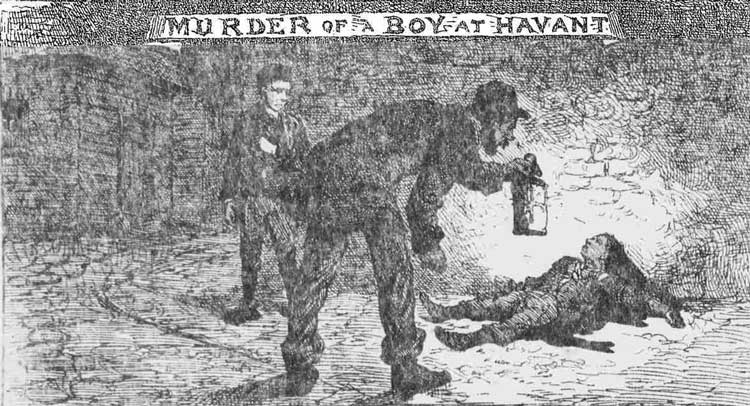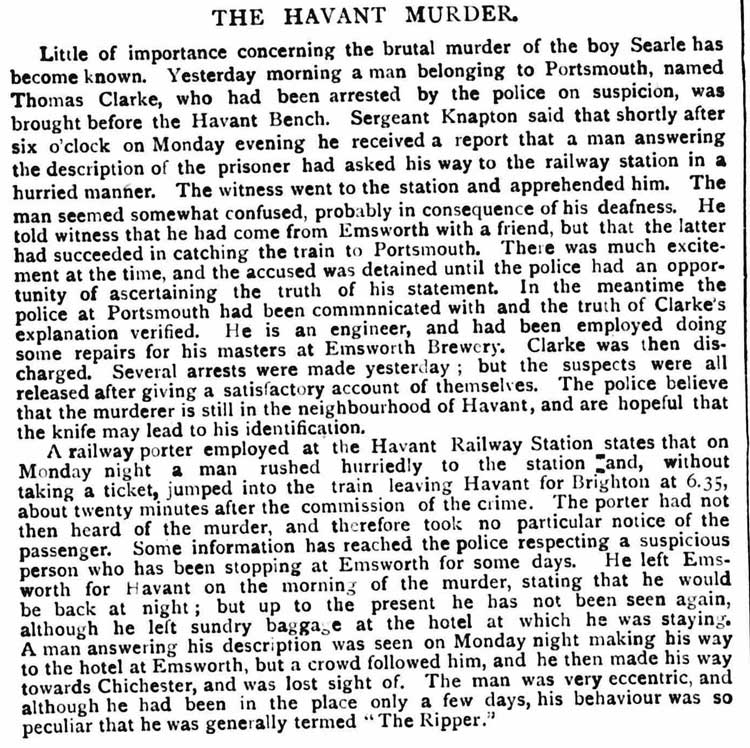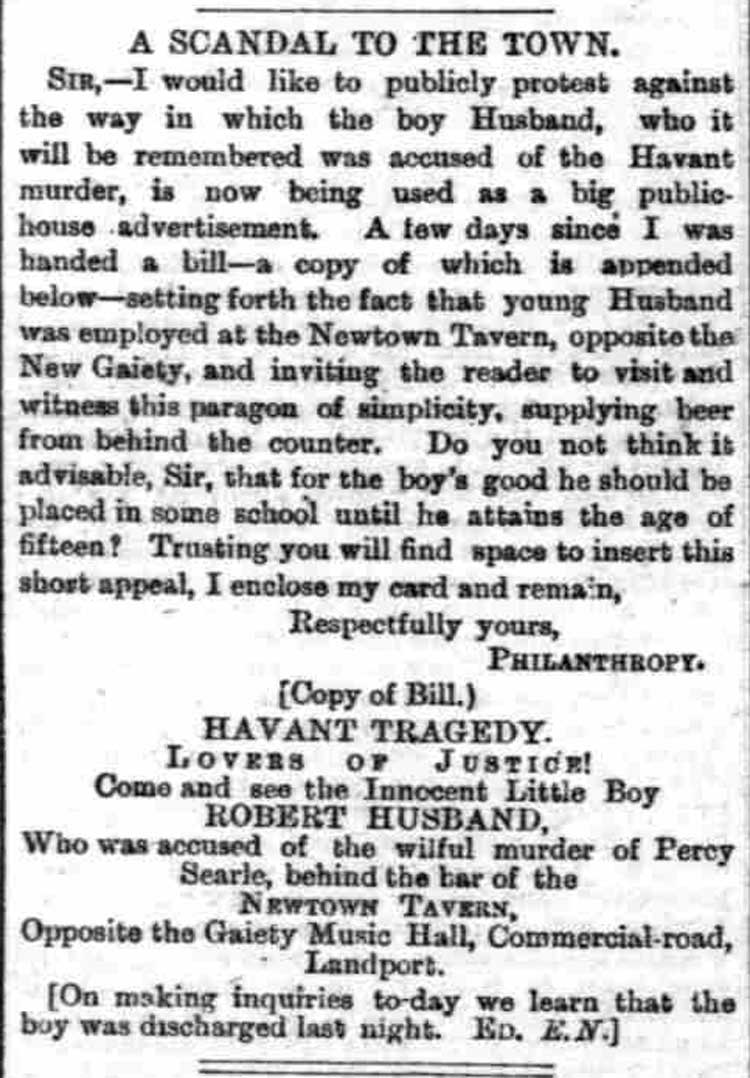In late November 1888, with London still recoiling at the horrific details of the brutal slaying of Mary Kelly that had taken place earlier that month, a murder took place in the Havant district of Portsmouth that bore certain similarities with the Jack the Ripper killings, and which, in some respects, was more shocking in its details, in that the victim was just 8 years old and the alleged perpetrator of the crime was but a few years older.
SENT ON AN ERRAND
At around 6pm on Monday 26th November 1888 eight-year-old Percy Knight Searle was sent by his mother to purchase a small amount of shirting from the draper’s shop run by Mr Randall on North-street, not more than three hundred yards distance from their home.
The boy, whom various press reports described as being “diminutive for his age”, was seen by several of his school friends as he made his way to the shop, and he duly purchased the required material and left to make his way home.
HE WAS ON HIS WAY HOME
According to an account in the Daily News, which appeared on Wednesday 28th November 1888:-
“On his return he had to pass through a thoroughfare known as New-lane, which at one spot is bounded on one side by the wall of the Manor House School, and on the other by Pallant House, now untenanted. It was in the darkness at this point and about a third of the distance home that the child was assailed.”
ROBERT HUSBAND SEES THE ATTACK
At around this time Robert Husband, aged 11, was, according to his later statement, sent on a errand by his father. As he passed the top of New Lane he “saw a man doing something to a boy.”
According to the report in the Daily News Husband had stated that:-
“It was very dark at the time, and my attention was called to the matter by a voice like that of a boy making a regular squeal, not as though he was being ‘hided,’ or anything like that. It was a queer sound, like a gurgling noise. There was a lamp at the top of the lane, and it shone on to Pallant House, which is opposite to the wall of the garden of Manor House School. When I heard the squeal I was about 25 yards from rounding the wall opposite Pallant House; and I saw distinctly the form of a man and a boy. The man had the boy down on the ground. I shouted “Murder!” as loud at I could. When I shouted murder the man ran away in the direction of the Fair-field. I ran as fast as I could to Mrs. Randall’s shop.”
HUSBAND FETCHES JOHN PLATT
On his way, however, he met dairyman John Platt whom he seized by the sleeve and, in a state of great agitation, blurted out to him:- “There’s a man up there murdering a boy.”
John Platt later stated that he had asked Husband to take him to the scene, but the boy had appeared very sacred and was reluctant to go with him. Platt, therefore, took him by the hand and led him quickly in the direction that he was sating that the attack was taking place.
On arrival at the wall of the school he found young Percy Searle lying in the road, bleeding profusely from three stab wounds in the throat.

THREE GASPS AND HE DIED
According to the report in the Daily News:-
“The child, who was in a pool of blood and mud, with the parcel of drapery in his hand, gave three gasps and died. Mr. Platt is confident that from the time that elapsed between him leaving Prince George’s-street and the boy, Husband, taking him by the arm, he must have been passing within a few yards of the spot at the very time the murder was being committed; but be neither saw nor heard anything.
Husband’s account is that the murderer was a tall, but beyond that he knew no details.”
THE POLICE ARRIVE
Platt sent Husband to fetch the police. However, instead of going for the police Robert Husband headed home and it was left to others to raise the alarm and alert the authorities of the murder.
Soon Sergeant Knapton had arrived at the scene, closely followed by Dr. F. St. Quintin Bond, who pronounced life extinct.
At the subsequent inquest Bond testified that:-
“There were three wounds in the throat, the only severe one being a punctured gash which penetrated a blood-vessel in the neck, causing death. The murderer apparently failed through the bluntness of the knife to cut the throat, and then dashed the point of the knife into the neck. Considerable force must have been used, but a boy might have committed the deed.”
As the doctor was examining the body, a search was made of the immediate surroundings and this led to the discovery of knife that was covered in blood, which was lying in the road a few yards away from the body.
A MAN ARRESTED
Over the next few days, the police, acting on the description of the assailant given by Robert Husband, arrested a man by the name of Thomas Clarke. The following report appeared in the St James Gazette on the 28th November 1888:-

THE POLICE BECOME SUSPICIOUS OF ROBERT HUSBAND
However, the police were beginning to grow suspicious of Robert Husband who, in the immediate aftermath had behaved in a decidedly suspicious manner. For one thing, when sent to fetch the police by John Platt, he had, instead, gone home and proceeded to wash his hands. Platt stated that he had gone round to the boys house, where he found him drying his hands on a towel.
Furthermore, Sergeant Knapton was becoming dubious that Husband could have seen what he claimed to have seen. The police officer, therefore, had “tested the accuracy of the boy’s statement as to seeing the murder by returning to the scene. He discovered that it was impossible to see a person at the murder site from the spot at which Husband had alleged that he had been standing when he had witnessed the attack.”
It then transpired that the bloodstained knife, which had been found near the scene of the crime, did, in fact, belong to Robert Husband’s brother, George.
As a result of the suspicions that the police entertained against him, Robert was not called to give evidence at the inquest. The Coroner, however, did ask Dr. Bond if it was at all possible that a boy could have inflicted the wounds onto the body of Percy Searle, to which the doctor replied that it was, indeed, possible.
ROBERT HUSBAND ARRESTED AND CHARGED
The police duly arrested Robert Husband and charged him with the murder of Percy Searle. According to The Western Times, his response on being charged was an emphatic, “I never did it.”

BLOODSTAINS ON HIS CLOTHING
However, at the police station, an examination of Husband’s clothing revealed “several spots of blood at the back of his wristband.” He accounted for these by claiming that he had cut his hand at work.
There were, however, newspaper reports that, “when the murdered boy was being laid out on the stretcher, Husband placed the hands and the legs of the deceased towards the body,” and this, it was claimed, may have accounted for how the bloodstains came to be on his clothing.
THE BLOODSTAINED KNIFE
The knife that had been discovered, so The Western Times informed its readers, had been:- “…identified by several persons. It originally belonged to a boy named Stevens, who gave it to Husband’s elder brother.”
George Husband later identified the knife as belonging to himself and stated that “he had missed it on the Sunday evening when out for a walk. He usually carried it in his jacket pocket, and on Sunday he changed it from his every-day clothes to his Sunday clothes. He did not see it after Sunday until it was shown to him by Sergeant Knapton.”
Henry Wheeler, an errand boy, then came forward to say that he had met the prisoner at about eleven on Monday morning of the murder. Robert Husband, he said, had shown him the knife and had asked him, “Will you give me a penny for this knife?” Wheeler told him that he did not want the knife.
I AM JACK THE RIPPER
As the police continued their investigations into the murder, several newspapers began looking into the personality of the accused, and some disturbing allegations were coming to light.
According to a report in Lloyd’s Weekly Newspaper, a school friend of the accused had told the police that, when they had been playing together, Husband had produced a knife and had told his companion, “I am Jack the Ripper. I do not mean any harm.”
The Western Times, meanwhile, informed its readers that “the accused is stated to have developed a very brutal temperament of late, and had frequently been reproved for his cruelty to animals.”
However, the paper also reported that:- “During an interview with his father last night, the accused completely broke down and wept bitterly.”
It seemed a fairly cut and dried case, at least as far as the police were concerned. Robert Husband had, evidently, murdered poor Percy Searle and had then invented the mysterious man in order to direct suspicion away from himself.
APPEARANCE BEFORE HAVANT MAGISTRATES
On Wednesday 5th December 1888, Robert Husband appeared before Havant magistrates charged with murder. The following is the report of his appearance that appeared in the next day’s edition of The Morning Post.

THE FINAL DAY OF THE INQUEST
The final day of the inquest into the death of Percy Searle took place on 12th December 1888.
The Morning Advertiser reported on the proceedings in its next day’s edition.
It mentioned the “I’m Jack the Ripper” incident and went into a little more detail:-
“Charles Clark, aged ten years, said he saw the accused at six o’clock on the night of the murder, when he said, “Here comes Jack the Ripper,” and simultaneously he put up an open knife. He pointed the knife at the witness. To the witness’s knowledge no other boy saw the circumstance. He could not swear to the knife.”
AN EXPERT WITNESS
Meanwhile, an expert witness, Professor Tidy, of Somerset House, London, to whom Husband’s bloodstained clothing had been sent for examination, and who had previously opined that the bloodstains found on the boy’s shirt were at least a month old, testified that:-
“…it would be extremely difficult to suppose that the fatal wound could have been inflicted without the hands or clothes of the murderer being bloodstained. Considerable force must have been used, and it would be very improbable that any person could have held the knife in the condition in which it was handed to him without getting his hands stained.”
NO BLOOD ON ROBERT’S HANDS
Referring to the condition of his son’s hands when he came in on the night of the murder, Robert’s father, also called Robert, stated that he had:-
“…sent his son at five minutes past six on the night of the murder to get some money from Mrs. Farnden. He returned about twenty minutes past six, saying a murder had been committed. He put a threepenny piece on the table, in the full view of himself and his wife. There was a double burner lamp burning at the time, and the witness saw no blood on his son’s hands. His mother ordered him to wash his coaly hands.”
According to The Morning Advertiser:-
“Fanny Husband, the prisoner’s stepmother, corroborated the evidence of her husband. She washed the towel on the following Wednesday morning, but there was nothing unusual upon it. The witness swore the clothes produced were those worn on the night of the murder. The prisoner had a clean shirt before the day of the murder. She did not notice any stains.”
THE INQUEST VERDICT
At five o’clock the court was cleared, and after more than two hours of deliberations, the jury returned a verdict of “Wilful murder against some person or persons unknown.”
But, as far as the police were concerned, the person responsible for the murder was already in their custody and it seemed certain to them that the outcome of his pending trial would be a unanimous verdict of “Guilty.”
HIS TRIAL FOR MURDER
Robert Husband’s trial for the “willful murder of Percy Knight Searle” took place at Winchester Assizes with Mr Justice Stephen presiding.
According to The Times, in a report dated 21st December 1888, his defending barrister, Mr Charles Mathews, argued in his summing up that:-
“the prisoner’s account was a truthful one, and that, having seen the occurrence, he ran back towards Randall’s shop as fast as he could to give information. The prosecution not only said the prisoner committed the murder, but also immediately invented the defence about it having been done by a man. As to the knife, he urged that it was impossible that the prisoner’s hands or clothes could have been free from marks of blood immediately afterwards if he had done the act. He also contended that it was physically impossible, owing to the prisoner and the deceased differing only one inch in height, that the blow which caused the death could have been inflicted by the prisoner, and this, added to the absence of any sign of struggle at the spot, pointed conclusively to the murder having been committed by a man. The prisoner’s whole conduct was inconsistent with guilt, and his story had always been the same, both before and after his arrest. His clothes were handed over to the police without demur, and on them, beyond two small spots of blood a month old, no traces of blood were found by Professor Tidy. In conclusion, referring to the question as to who was the actual culprit, Mr. Mathews alluded to the tragedies which had occurred in London, in which no culprit had yet been found. He pointed out that several trains left Havant almost directly after the time of the murder, and that thus escape was possible; and, while hoping that the culprit might be discovered, he said the matter must remain, for the present, shrouded in mystery.”
THE JUDGE SUMS UP
Mr Justice Stephen – who, according to The Illustrated Police News in its report on the trail, “is perhaps our greatest authority on criminal law” – informed the jury in his summing up that:- ” a crime done by any person over seven and under fourteen is a crime, unless it be shown affirmatively that such person had sufficient capacity to know that the act was wrong.”
The jury must, he informed them:- “be satisfied that the boy had some adequate conception of the wickedness of the act and its awful consequences before they could convict him.”
Furthermore, he asked the jury to:- “recall to their minds what they themselves were at the age of 11, and the thoughts and feelings which then actuated them, and, in considering the case, to remember that the prisoner was now not unlike what they were then.”
Referring to the allegation that the prisoner had told a companion that he was “Jack the Ripper”, he advised the jury they would probably conclude that this was nothing more than “childish play”.
Although, he said, it was “strange that the crime should have been committed at all…the question for them was, Did they feel quite sure that the prisoner did it?”
FOUND NOT GUILTY
Evidently, the jury took Mr Justice Stephen’s advice to heart and, having retired to consider their verdict, they returned and, after just ten minutes deliberation, they found Robert Husband “Not Guilty” of the murder of Percy Knight Searle.
He was duly discharged, and went home to a heroes welcome. Indeed, according to The Times:-
“A singular scene was witnessed at Havant last evening. When Husband reached his home a large number of his former playmates met him and congratulated him on the results of the trial.”
The Illustrated Police News, meanwhile, opined that:-
” The boy has had to pass through a terrible ordeal; but it is gratifying to know that on his return home he was met by many of his former playmates, who had all through maintained his innocence.”
SOMETHING OF A LOCAL CELEBRITY
From that point on it appears that Robert Husband became something of a local celebrity.
On March 5th 1889, a reader wrote to the editor of Portsmouth’s Evening News to complain that it was nothing short of scandalous that “the boy Husband is now being used as a big public house advertisement.”
Below you can read below the full letter of complaint together with the offending advert.

THE CRIME WAS NEVER SOLVED
Nobody was ever brought to justice for the murder of Percy Knight Searle. There were press reports in December 1889 that a man named John Henry Thompson, alias Jones, had confessed to the murder. But, he got so many of the facts surrounding it wrong that the police were convinced that he could not have been responsible and that his statement was, according to The Western Times, “worthless.”
Indeed, once Robert Husband was acquitted, the police, as far as can be ascertained, devoted so little time to continuing their investigation that it seems that they were convinced that Husband was guilty and that he had, quite literally, got away with murder.
